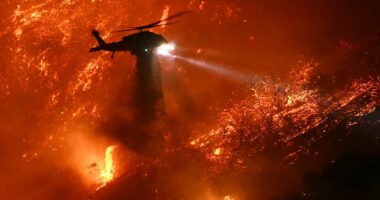Share this @internewscast.com
Three astronauts who have already spent six months in space are now facing an unexpected extension of their mission. They find themselves stranded in orbit after their spacecraft may have been compromised by hazardous debris floating around Earth.
The China Manned Space Agency (CMSA) disclosed that the crew from the Shenzhou 20 mission will need to continue their stay aboard the Chinese space station, Tiangong.
Their successors had managed to reach the space station after launching on October 31, with plans for a smooth transition between crews.
Since their arrival in April, astronauts Chen Dong, Chen Zhongrui, and Wang Jie have been diligently working aboard Tiangong, which translates to “Heavenly Palace.” Their work has included conducting scientific experiments, performing spacewalks, and adapting to life in zero gravity.
However, before the official handover to the Shenzhou 21 crew on November 5, complications arose. The capsule intended to bring the astronauts back to Earth was struck by an unidentified object while in orbit.
This collision left a visible mark on the exterior of the spacecraft, raising concerns about potential internal damage that could jeopardize their return journey. As a result, the team must remain in space while further assessments are carried out.
The two astronaut crews will now have to comb through the spacecraft to check for any critical problems before attempting to use the craft again. The next return data has not yet been released.
It’s the second time this year that an astronaut crew has been stranded in space due to a problem with their space capsule, taking place just seven months after NASA’s Suni Williams and Butch Wilmore were rescued from the International Space Station.

Astronauts Chen Dong, Chen Zhongrui, and Wang Jie (Pictured) have been stranded on the Chinese space station Tiangong until their return vehicle can be repaired

Shenzhou 20 (Pictured) launched in April and was scheduled to return to Earth on Wednesday, but it’s believed that space junk damaged their craft
Chinese officials are unsure what struck the spacecraft, but the damage is believed to have been caused by space debris, which is basically junk floating around the Earth from older space missions and rocket launches.
This could include anything from bits from broken satellites and dropped tools from spacewalks to giant pieces of discarded rocket parts.
This floating garbage is moving around the planet at incredible speeds of up to 17,000mph, the average velocity for objects in low Earth orbit.
This can be a real hazard for manned spacecraft, similar to driving through a hailstorm of bullets.
Right now, there are about 19,000 pieces of space debris in Earth’s orbit that the US is tracking, not counting the satellites still working.
However, experts at NASA think there could be over half a million smaller pieces too small to track easily.
‘The impact analysis and risk assessment are underway,’ officials at CMSA said, according to CNN.
However, the agency did not provide any details on how long it might take the crews of Shenzhou 20 and 21 to check the ship and repair whatever damage was done.

China’s Tiangong space station (Pictured) was launched in 2021 and orbits about 250 miles above Earth
This isn’t the first time space debris has struck a manned spacecraft while astronauts orbited the Earth.
Russia’s Mir space station was repeatedly struck by tiny pieces of space junk during its lifespan in the 1980s and 1990s.
The International Space Station (ISS) has also been on the receiving end of several collisions with debris, including some incidents that caused significant damage to the US and Russian-led space lab.
In 2021, a piece of space junk left a hole in one of the station’s robotic arms.
Just a year later, an unknown object hit a docked Russian Soyuz spacecraft, putting a nearly inch-wide hole in its radiator and causing a coolant leak.
As for the crew of Shenzhou 20, it’s not currently known what the backup plan will be if the damage to their craft cannot be repaired.
The Shenzhou 21 mission was also scheduled to last for six months on board the station, which is exclusive to Chinese astronauts.
















